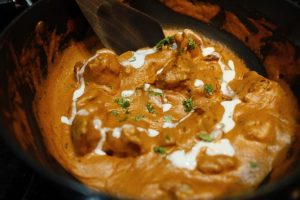What is coriander? It is the seed of the cilantro plant. Coriander is often used in Mexican and Indian cuisine. Coriander is also known as Chinese parsley or cilantro. You can use the leaves or seeds in your recipes. In fact, they are both edible parts of the plant. But coriander seeds have a much different flavor than other parts of the plant. The leaves have a lemony, citrus taste to them. They add a little zest to your dishes. Coriander seeds can be used as a whole spice or ground into a powder for easy use. They are commonly found in curries, chili and other South American dishes.
Coriander pairs well with many ingredients such as garlic, cumin and lemon juice to name a few. They also complement foods like chicken, beef, fish and lamb. The plant is native to southern Europe and the Middle East but has been cultivated in many areas around the world today. India is one of the largest producers of coriander seeds today. And it’s no wonder since it’s so popular in many Indian dishes like curry and dal. You may have heard that coriander and cilantro come from two different plants but they are actually
Coriander (also known as cilantro) is a green leafy herb that is popular in Mexican, Latin American, Indian, Middle Eastern and Asian cuisine.
Coriander is commonly used for its seeds, leaves and stems. The fresh leaves of the plant are known as cilantro and have a very distinctive taste.
What Is Coriander?
The coriander plant is native to regions spanning from Southern Europe and Northern Africa to Southwestern Asia. It belongs to the Apiaceae family, which includes carrots, celery and parsley. Coriander is one of the oldest known herbs and has been found in ancient Egyptian tombs dating back to around 3000 B.C.
An annual herb, coriander grows quickly during its first year of growth before flowers appear and seeds begin to form. The seeds are oval or round in shape and can be yellow or brown in color depending on variety. They have a strong aroma that’s nutty, earthy and spicy all at once.
The plant has long been used as an herbal medicine to treat digestive and gastrointestinal disorders like diarrhea, flatulence and indigestion. There are many different varieties of the coriander plant that have slightly different characteristics including:
the Moroccan
Coriander is a member of the parsley family, and its seeds are used as a spice. Coriander is often called cilantro, but this word actually refers to the leaves of the plant. Both the leaves and seeds of coriander have been used in cooking and medicine for thousands of years.
The scientific name for coriander is Coriandrum sativum. The plant belongs to the Apiaceae family, which also includes carrots, dill, fennel, and parsnips 1.
Coriander seeds have a lemony citrus flavor when crushed, due to bitter pinene and linalool oil compounds. They have been used in cuisine worldwide for thousands of years — in Mexico since at least 7000 BC 2.
The plant is a small annual that grows about 30–50 cm (12–20 inches) tall 3. Its leaves are variable in shape, broadly lobed at the base of the plant and slender and feathery higher on the flowering stems 4. Its flowers are borne in small umbels, white or very pale pink, asymmetrical, with the petals pointing away from the center of the umbel longer (5–6 mm) than those pointing toward it (only 1–3 mm long
Coriander, also known as cilantro or Chinese parsley, is an annual herb in the family Apiaceae. All parts of the plant are edible, but the fresh leaves and the dried seeds are the most commonly used in cooking. Coriander is native to regions spanning from southern Europe and northern Africa to southwestern Asia. It is a soft plant growing to 50 cm tall. The leaves are variable in shape, broadly lobed at the base of the plant, and slender and feathery higher on the flowering stems. The flowers are borne in small umbels, white or very pale pink, asymmetrical, with the petals pointing away from the center of the umbel longer (5–6 mm) than those pointing toward it (only 1–3 mm long). The fruit is a globular, dry schizocarp 4–10 mm diameter. The earliest attested form of the word is the Mycenaean Greek ko-ri-ja-da-na (*koriadana), written in Linear B syllabic script.
Coriander has been used as a source of food and medicine since ancient times. In Ayurveda traditional medicine system, coriander has been used for its anti-diabetic properties.
Coriander is a type of flowering seed that is used as a spice and herb.
Coriander is native to the Mediterranean and parts of Africa, Asia, and Europe. The seeds, leaves, and stems are all edible.
The most common types of coriander are green (cilantro) and brown (seeds). The brown seeds are usually ground into a powder. The green leaves are called cilantro (also Chinese parsley or coriander leaves).
Coriander seeds and leaves have been used for thousands of years in traditional medicine practices in India, China, the Middle East, and several other countries.
Benefits:1)High in Antioxidants
Coriander, also known as cilantro or Chinese parsley, is an annual herb in the family Apiaceae. All parts of the plant are edible, but the fresh leaves and the dried seeds (as a spice) are the parts most traditionally used in cooking.
Coriander is native to regions spanning from southern Europe and northern Africa to southwestern Asia. It is a soft plant growing to 50 cm (20 in) tall. The leaves are variable in shape, broadly lobed at the base of the plant, and slender and feathery higher on the flowering stems. The flowers are borne in small umbels, white or very pale pink, asymmetrical, with the petals pointing away from the center of the umbel longer (5–6 mm or 0.20–0.24 in) than those pointing toward it (only 1–3 mm or 0.039–0.118 in long). The fruit is a globular dry schizocarp 3–5 mm (0.12–0.20 in) in diameter.[2]
Coriander seed contains essential oil with terpenes, primarily linalool and geraniol. The dry fruits are known as coriander seeds; Cilantro refers to its leaves
Coriander is a spice produced from the round, tan-colored seeds of the coriander plant (Coriandrum sativum), which is a member of the parsley family. The seeds are used in cooking and are known for their lemony flavor that works well in curries and stews.
There are many different types of coriander, including:
Cilantro: Also called fresh coriander, this refers to the leaves of the coriander plant. It’s also known as Chinese parsley or dhania and has a flavor that’s similar to a mix of parsley and citrus. Cilantro can be used in salsa, guacamole and Asian dishes.
Coriander seed: The dried, ripened fruit of the coriander plant is sold whole or ground into a fine powder. It has an earthy aroma with subtle citrus notes.
Chinese parsley: This type of coriander comes from southern China and Southeast Asia, where it’s commonly used in cooking. It has very large, flat leaves with bright green coloration.
Vietnamese coriander: This variety is grown throughout Vietnam, Japan and parts of China. It features long, narrow leaves that are often used as herbs since

